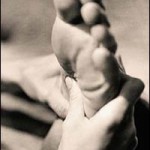
The human body is a complex and wonderful piece of machinery. With our brains we are able to feel emotions that can manifest themselves in physical ways throughout the body. By the same token, massage therapists have discovered a way to map out the body’s organs and access them through our hands and feet. It’s called reflexology, or what was known early on as “zone therapy.”
Reflexology massage operates on the principle that the entire body is connected. Applying pressure to one part of the body can cause a reaction in another area. Have you ever seen the cartoon where the doctor uses a little triangular rubber mallet to tap the knee of his patient and the patient’s arm shoots out and hits him? What’s supposed to happen (and does with real people) is that your leg shoots out when the area just below the kneecap is hit.
Doctors have mapped out the body systems (organs, glands, muscles and tissues) on the hands and feet. Stimulating the area that corresponds to the system that is experiencing trouble, results in a change in that body part. The maps are specific so a massage therapist licensed in reflexology massage will know exactly where to put pressure on your feet or hands.
How does this work? According to ancient Chinese medicine, lines of energy called qi (pronounced chee) run throughout our bodies much like the meridian lines on a globe. Any block along an energy line will cause a problem in an organ or other vital tissue in the body. The purpose of massage therapy is to restore the body to proper balance by restoring the flow of energy.
For a reflexology massage you will stay clothed. The therapist will only be massaging your hands and feet so you will need to remove your socks and shoes. If you are self-conscious about your paws, have a manicure and pedicure before heading over for your massage.
You will likely be sitting in a massage chair in a comfortable position. Remember that this is not a hand or foot massage but a way to use pressure to access different parts of the body that are experiencing conditions such as arthritis, headaches, back pain and common digestive system complaints. You will feel the massage therapist exerting pressure but it should not hurt in any way. Some people notice that they can feel pain going away in a variety of places during and right after a reflexology massage.
Want to try something new for those headaches or that joint pain that won’t go away? A reflexology massage might be just what the doctor ordered.
Reflexology Massage: Zone Therapy
The human body is a complex and wonderful piece of machinery. With our brains we are able to feel emotions that can manifest themselves in physical ways throughout the body. By the same token, massage therapists have discovered a way to map out the body’s organs and access them through our hands and feet. It’s called reflexology, or what was known early on as “zone therapy.”
Reflexology massage operates on the principle that the entire body is connected. Applying pressure to one part of the body can cause a reaction in another area. Have you ever seen the cartoon where the doctor uses a little triangular rubber mallet to tap the knee of his patient and the patient’s arm shoots out and hits him? What’s supposed to happen (and does with real people) is that your leg shoots out when the area just below the kneecap is hit.
Doctors have mapped out the body systems (organs, glands, muscles and tissues) on the hands and feet. Stimulating the area that corresponds to the system that is experiencing trouble, results in a change in that body part. The maps are specific so a massage therapist licensed in reflexology massage will know exactly where to put pressure on your feet or hands.
How does this work? According to ancient Chinese medicine, lines of energy called qi (pronounced chee) run throughout our bodies much like the meridian lines on a globe. Any block along an energy line will cause a problem in an organ or other vital tissue in the body. The purpose of massage therapy is to restore the body to proper balance by restoring the flow of energy.
For a reflexology massage you will stay clothed. The therapist will only be massaging your hands and feet so you will need to remove your socks and shoes. If you are self-conscious about your paws, have a manicure and pedicure before heading over for your massage.
You will likely be sitting in a massage chair in a comfortable position. Remember that this is not a hand or foot massage but a way to use pressure to access different parts of the body that are experiencing conditions such as arthritis, headaches, back pain and common digestive system complaints. You will feel the massage therapist exerting pressure but it should not hurt in any way. Some people notice that they can feel pain going away in a variety of places during and right after a reflexology massage.
